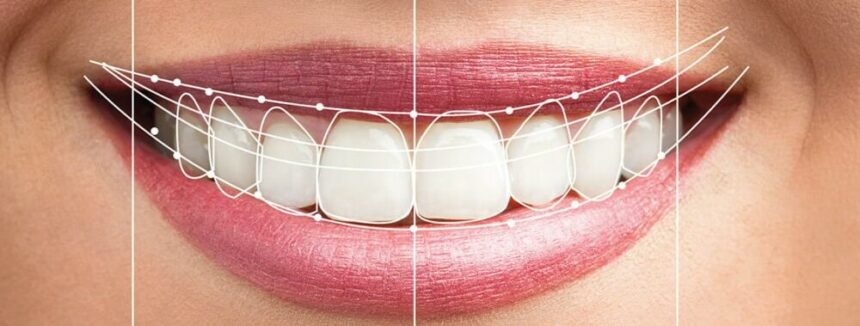Cosmetic dentistry is moving toward a transformative era, and in this new world, Digital Smile Design stands out as a sophisticated tool that has totally changed the criteria for aesthetic enhancement. This isn’t your father’s smile. Unlike conventional methods taught in dental schools over the past three decades, DSD eschews the one-size-fits-all approach to smile design in favour of an ever-more personalised science for creating particular types of smiles. Dentists can use the DSD system to plot out every aspect of a patient’s “ideal” or “’#NewSmile’.
The field of dentistry is continually transformed by technological advancements, and one standout innovation is Digital Smile Design (DSD). This method employs state-of-the-art software and advanced techniques to craft custom, lifelike smiles. DSD allows dentists to comprehensively plan and preview a patient’s smile enhancement before any treatment begins. With this technology, every aspect of a smile’s aesthetics, functionality, and overall health can be improved with unprecedented precision. This cutting-edge approach ensures that treatments are precisely tailored to meet the individual needs and preferences of each patient, boosting their confidence with beautifully restored smiles.
The digital smile design is a treatment planning concept for dentistry and aesthetics. It uses the latest in digital technology to plan the very essence of dental treatment—and this integral part is often misunderstood. Why? Because it logically follows that if you want to understand dental aesthetics, you need first to understand what constitutes a particular patient’s oral and facial appearance—his or her unique form. So we start with high-resolution images and videos of said forms; indeed, we even use these to create virtual simulations that African Smile Program dentists can tailor precisely to each individual’s situation, talk about ‘a desktop minute’ when planning for overrides!
The age of digital communication has transformed every aspect of our lives – and that includes dentistry! Digital Smile Design is quickly becoming the new norm in cosmetic dentistry due to its many advantages over traditional methods. In this modern approach, highly advanced software is used to create a personalised and precise plan for each patient’s unique smile. This not only allows the dentist and patient to visualise the final result but also enables them to make any necessary adjustments before actual treatments are initiated. Moreover, with digital technology comes increased accuracy, reduced risks of human error, and faster treatment times compared to conventional methods. Additionally, patients can have a better understanding of what they can expect from their treatments thanks to digital visualisation aids. Ultimately, Digital Smile Design offers numerous benefits by providing patients with not only aesthetically pleasing results but also an enhanced overall dental experience.
60% of the facial appearance is above the neck, with only 40% between the cheekbones to the chin. Still, most dentists do not consider this when designing smiles and do not even have a basic understanding of facial anatomy. At ADA Health Services, we can now see how IDX (Index of Facial Esthetics) can relate to dentist-reported confidence in patients’ smiles: For every unit increase in an ID T-Score—the more severe the aesthetic problem—the one-unit decrease in IDX yields greater confidence in patients’ smile aesthetics.
Improved patient involvement and satisfaction come naturally with DSD. The design phase takes on an almost interactive quality, where the patient becomes an active participant. But why should we expect this to lead to a certain class of results when it comes to.
The main benefits of digital smile design is the accuracy. When you consider the chemistry of a smile—how it must look in each individual context, with all its unique particularities—you can understand why visuals become so crucial. Our detailed previews allow dentists to not only see but also experience the treatment plan before moving on to the actual procedure. This makes the process inert to proceed in that critical space between vision and reality, ensuring that what the dentist sees during rendering translates into an equally satisfying result for the patient.
How can dentists achieve clear, consistent communication with their patients? By using the
The first few seconds of meeting someone are crucial. These short moments can and do set the stage for just about everything that follows in the relationship. That’s why these critical moments are called ‘the moment of truth.’ And, as with all important moments in life, a good dentist can make it even better by associating this moment with something positive.
The planning and simulation part of direct restorative dentistry lets the dentist look at most likely problems well before starting work on actual treatments. This allows time (and thus, a few extra breaths) for most kinds of potential issues to be resolved. We save time (and therefore reduce patient discomfort and recovery duration) during the procedure itself, leading overall to a vastly more efficient process for our patients.
The ethics of biomedical engineering focus on the responsible deployment of healthcare technologies, emphasising the importance of considering all stakeholders. Central to these ethical considerations are principles such as protecting patient autonomy, ensuring informed consent, prioritising safety, and promoting equitable access to technologies. Ethical decision-making in this field must also reflect on the wider societal impacts of innovations, aiming to enhance social welfare. To maintain trust and protect patients effectively, it is essential to continuously engage in reflective practices, open dialogue, and adhere to established ethical guidelines in the pursuit of balancing the potential benefits and risks associated with biomedical engineering projects.
There’s more to Digital Smile Design than just dental treatments; it’s a total approach to aesthetic dentistry that connects beauty with the dentist’s craft. And when you consider “going digital” in your quest for cosmetic dentistry, DSD is as good as it gets. The payoff: not only will your smile look absolutely beautiful, but the pathway to getting there is largely free of twilight-zone jax risks and uncertainties — except, perhaps, if you’re going after a particular set of Results That Everyone Can See and Award Points For.








